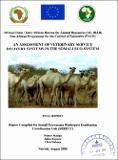| dc.description.abstract | Rinderpest eradication is a global objective and the African Union / Inter African Bureau for Animal Resources (AU / IBAR), through the Pan African Programme for the Control of Epizootics (PACE), is spearheading the eradication campaign in the African continent. The region termed the "Somali Eco-system" [SES] is presumed to harbour the last foci of Rinderpest in the world. Apart from the disease risk posed by these foci there is also a considerable negative economic impact on the market value of livestock with consequent adverse effect on the livelihoods of the pastoralist communities. The African Union / Inter African Bureau for Animal Resources / Somali Ecosytem Rinderpest Eradication Coordination Unit ( AU/IBAR/SERECU) operating under the PACE programme is seeking to develop a harmonized and coordinated surveillance and Rinderpest eradication strategy to achieve "freedom from Rinderpest" in the SES in line with OIE guidelines. However there are perceived gaps in the current AHDS within the SES, which may be impairing disease surveillance and consequently Rinderpest eradication capability. The AU/IBAR/SERECU has therefore commissioned an independent and expert assessment team to advise on the remedial needs of the existing veterinary service delivery systems in SES. A three-man mission was recruited with each consultant responsible for one of the three countries in the Somali Ecosytem (SES). The consultants undertook field visits to conduct a census of the Animal health Service Deliverers; assess the networks of vet-paraprofessionals supervised by private and public veterinarians in the area; assess the roles and linkages between the different players in veterinary services on the ground and identify gaps in service delivery - suggesting ways these can be remedied. Results / Observations A fmding common to all three countries is the existence of gaps and deficiencies in AHDS for which substantial resources, manpower and a review of policy will be required to make good. It is considered that creating a sustainable Animal Health Delivery System (ANDS) in the SES, which is expressly designed to supply the quality and quantity of livestock services as required by the pastoralist livestock keeping communities, will be the most cost-effective way to achieve AU/IBAR/SERECU disease surveillance and Rinderpest eradication aims. The approaches to strengthening the delivery of ANDS in the SES will have some elements in common but there will also need to be some country specific approaches in recognition of the differences in Veterinary Delivery systems existing on the ground in each of the three countries. The delivery of animal health services in the whole of the SES is under-resourced, often requiring staring and transport reinforcements when specific delivery tasks are to be implemented. In Ethiopia and Kenya, the delivery of veterinary services, including vaccination and disease surveillance, is mainly undertaken by the Government, with
some assistance from Non-Governmental Organizations (NGOs), Community Animal Health Workers (CAHWs) and the livestock keepers themselves. Private sector involvement is extremely limited. In Somalia, by contrast, the delivery of animal health services is dependent on the private sector; there is no Government service at all. The service provision is mainly by Veterinarians, Animal Health Assistants (AHAs), CAHWs, NGOs and Livestock Keepers. Quality controlled animal health service delivery requires that veterinarians, either private or public, are the principal agents in directing the service delivery system and providing a lead role in technical guidance, coordination, supervision and monitoring. In all three countries, veterinarian-supervised networks of para-professionals are few, generally weak and poorly resourced. Strengthening and extending these networks to serve the entire livestock owning community needs to be undertaken as a priority action. The roles of the various players in animal health service delivery in SES (Government, NGOs, Associations, CAHWs, drug suppliers and livestock keepers) are defined to a large extent, but in practice some players do not adhere to their roles due to inadequate coordination and control. Disease reporting systems in SES is clearly defined but mechanisms to ensure adherence are weak. Community animal health workers provide a useful link between the livestock keepers / community and the District Veterinary Authorities in terms of disease reporting and surveillance but as a whole, there is no motivation for them to submit reports, nor is there any tangible compelling mechanism in place to make them accountable. The valuable role that CAHWs can play in the frontline delivery of Animal Health Services in the SES is well recognised, but there is concern at the apparent lack of supervision, regulation and prospects for sustainability. In recognition of the importance of wildlife as sentinels for Rinderpest, disease surveillance capacity requires strengthening in Ethiopia and Somalia, whilst in Kenya better linkages at District level are required. In all the three countries, the main service delivery gaps include deficiencies in skilled manpower; weak district veterinary services with insufficient equipment, facilities and incentives; low level of community participation; underdeveloped private sector (except in case of Somalia); weak linkages; poor drugs supply system; and limited knowledge of CAHWs on surveillance and diagnosis of mild Rinderpest. Recommended interventions centre on resolving these deficiencies. In Kenya and Ethiopia, the priority point of intervention is at the District level, focusing on the Government Veterinary Service, the Private Sector, Community Animal Health Service delivery system and the Community. In Somalia, the priority point of intervention is the establishment of Central Veterinary Authority, along side strengthening of Professional Associations and training of more service providers | |
